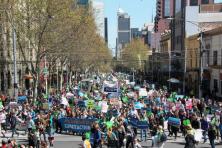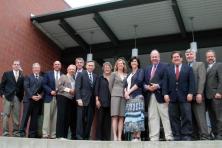For livability, equity, and attractiveness, cities need affordable housing with access to walking, biking, and public transit routes. Well-designed affordable housing near good public transportation can also be a powerful climate solution by reducing urban sprawl, protecting rural open space, and providing infrastructure efficiently, all of which reduces regional carbon emissions, particularly from transportation.
The 2008 Urban Land Institute’s Growing Cooler report found that shifting 60 percent of new growth to more compact transit-oriented development patterns would lead to 20 to 40 percent less driving, saving 79 million metric tons of carbon dioxide annually by 2030.
In King County, Lawrence Frank and Company found in 2005 that residents of the most walkable neighborhoods drove 26 percent fewer miles than those living in areas of greater sprawl. Fewer miles traveled translate directly to lower tailpipe emissions.
Indeed, the King County region needs affordable housing within cities to halve its carbon by 2030, and specifically to reduce vehicle miles traveled (VMT) 20 percent by 2030, part of a package of goals that King County and 11 members of the King County-Cities Climate Collaboration adopted in January 2015.
To achieve these goals requires: continued strong leadership on land use planning and policies at the regional scale that encourage density and direct growth into urban areas; affordable housing on the scale that the City of Seattle is currently exploring; and dramatic expansion of affordable transportation options, such as Move Seattle and King County’s acclaimed ORCA Lift program. These policies and programs can be a powerful combination, but only if they work hand-in-hand.
Of course, cities are on the front lines of this issue. Seattle is wrestling with how to create equitable, climate-smart housing in a way that maintains neighborhood character and Shoreline, WA is planning ahead for two light rail stations that will open in 2023.
Forecasted to grow significantly in the coming decades, Shoreline has been developing specific plans to accommodate more housing, jobs, and businesses in close proximity to transit. Other King County cities will absorb this growth as well; the question is how low-carbon and equitable the results will be.
Puget Sound is not alone in walking this path, as federal and state officials have encouraged density and affordable housing near transit in other communities across the country:
- Through the American Recovery and Reinvestment Act, federal housing, transportation, and environmental officials partnered to “help communities improve access to affordable housing and transportation while protecting the environment,” with the guiding principles of: providing more low-carbon transportation choices; promoting equitable, location-efficient, and low-energy housing choices; and valuing the unique existing characteristics of communities and neighborhoods.
- California is directing revenue from its carbon cap-and-trade auction to the Affordable Housing and Sustainable Communities program, which is charged with “reducing greenhouse gas emissions by encouraging the development of affordable housing near transit, and creating walkable, bikeable communities that encourage few car trips.”
But the powerful combination of smart land use, affordable housing, and low-carbon transportation depends on all of the puzzle pieces being in place, as another Urban Land Institute report, 2009’s Moving Cooler, concluded. Indeed, Vancouver, BC has excelled at meeting its low-carbon transportation goals, but still struggles mightily with affordable housing.
The road is not easy, but affordable housing is an important urban planning issue and a climate solution.




